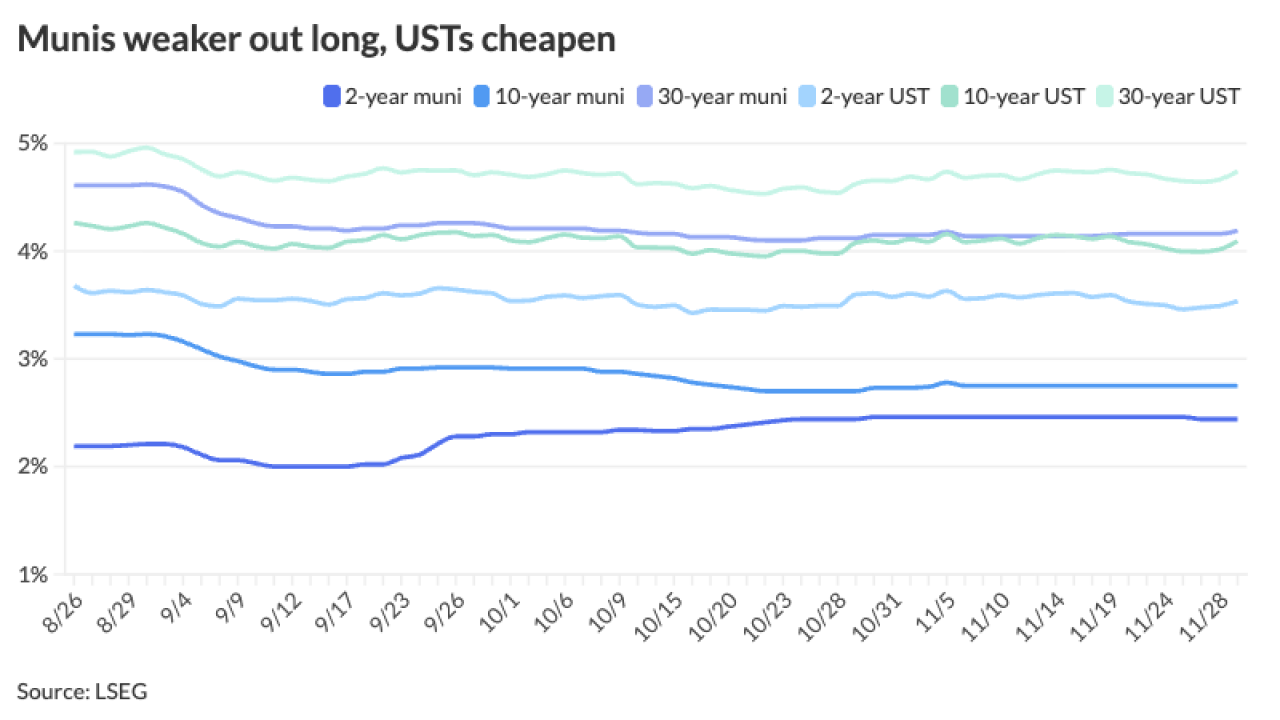
DALLAS — New Orleans will remove unsecured, taxable variable-rate pension debt seen as dragging down the city’s credit quality at the cost of a huge swap-termination payout.
The city plans on Thursday to price a negotiated $198.6 million refunding of taxable fixed-rate bonds that will, unlike the bonds being refunded, be backed by a property tax.
Proceeds will provide $126.8 million to refund $109.2 million of outstanding taxable pension bonds from a $170.7 million issue in 2000 without extending the maturities. The bonds have been in bank mode since weekly remarketing failed in March 2008.
The sale will also provide a $46.8 million swap termination payment to PaineWebber Capital Services, and refund $16 million of bonds issued in late November 2011 to refinance certificates of obligation from 1998.
Other allocations include a $14.9 million capitalized interest fund and an $8.9 million debt-service reserve fund.
First deputy mayor Andrew Kopplin said Thursday’s sale will remove what he called “a blot” from the city’s books. The refunding also allows New Orleans to avoid a $115 million bullet payment on the bank-mode pension debt that would be due in spring 2013.
“It is a huge part of restoring the city’s credit,” Kopplin said.
“The unsecured pension bonds have been a big point of conversation every time we’ve meet with the rating agencies over the two-and-a-half years that I’ve been at City Hall,” he said. “We’re putting that challenge behind the city and cleaning up the balance sheet.”
Debt service on the refunding bonds will be supported by a property tax authorized for New Orleans by the Louisiana state constitution, Kopplin said.
“This sale will alleviate a major concern of the financial community,” he said. “We’re replacing the 2000 debt with bonds backed by the property tax, and we’re going to pay a lower interest rate on the new bonds.”
The constitutional provision the city is using “is as secure as any credit support that you can get,” he said.
The limited-tax refunding bond ratings range from BBB-plus with a stable outlook by Fitch Ratings, A with a stable outlook by Standard & Poor’s, and A3 with a negative outlook by Moody’s Investors Service.
The outstanding pension obligation bonds are rated Baa3 by Moody’s and BBB-minus by S&P.
New Orleans’ $509 million of outstanding GO debt is rated A3 by Moody’s and A-minus by Fitch.
The pension bonds were issued in 2000 as variable-rate debt with a standby bond purchase agreement through JPMorgan Chase and insurance from Ambac Assurance Corp.
The debt was hedged through a swap with PaineWebber Capital Services Inc., with a synthetic fix of 6.95%.
Proceeds from the 2000 issue funded a portion of the then-current projected unfunded accrued liability of a city firefighters’ pension plan.
The city has been paying debt service of $19 million a year on the pension bonds since the remarking failed in 2008, according to Kopplin.
That is $5 million a year more than had been expected when the debt was first issued.
JPMorgan could have charged an interest rate of 11.95% on the bonds when the remarketing failed in 2008, he said, but instead set the rate at 9.95% in light of the city’s precarious financial position in the wake of Hurricane Katrina in late August 2005.
Still, according to Kopplin, if the termination payment is included, the city paid an effective rate of 11% on the unsecured debt.
Lisa Daniel, a managing director with Public Financial Management Inc., said the first two years of debt service on the refunding bonds will come out of the capitalized interest fund established with the proceeds.
Revenue from the 13.9-mill property tax is currently dedicated to debt service on street maintenance bonds issued in 2004, which will mature after payments of $13.4 million in 2013 and $13.5 million in 2014.
“The 2004 bonds are the only remaining obligation for the tax, but they were not callable,” Daniel said. “The debt service fund will smooth the city’s payments until those bonds mature.”
Principal repayments for the refunding will begin in 2015, with no extension of the 2030 maturity of the original pension bonds, she said.
The constitutional general municipal purpose tax, also known as the alimony tax, is expected to generate $36 million in 2012.
Annual debt service on the 2012 debt is estimated at $18.1 million. If revenues falter, the city can increase the rate to a sufficient level.
New Orleans has substantially recovered from the devastation caused by two hurricanes in 2005, Kopplin said.
“This area is on a roll and moving in the right direction,” he said, adding that New Orleans is the fastest-growing major city in the country is and creating hundreds of well-paying jobs.
“There’s a lot of energy and creativity in New Orleans, and that is growing,” Kopplin said.
The city recently overcame its most pressing challenge, he said, as the flood protection measures taken since Hurricanes Katrina and Rita proved effective when Hurricane Isaac hit the area in late August.
“The billions of dollars of protective infrastructure financed by U.S. taxpayers worked as designed,” Kopplin said.
The city’s 2012 population is estimated at 360,740 residents, almost 80% of the pre-Katrina level and significantly more than the 233,000 remaining after the hurricane.
Assessed property valuations fell by 22% after the storm, to $1.67 billion. Valuations have increased 77% since then to $2.95 billion in 2012.
Assessments are expected to grow by 9% in 2013.
Raymond James | Morgan Keegan is lead manager on the taxable sale. Co-managers include JPMorgan, Goldman Sachs, Loop Capital Markets, Dorsey & Co., and FFC Capital Advisors.
Foley & Judell LLC and Auzenne & Associates LLC are co-bond counsel.
PFM and CLB Porter LLC are co-financial advisors to New Orleans.
Finance director Norman Foster said the city expects to issue general obligation bonds from a 2004 authorization later this year or early in 2013.
“I expect the issue will be about $40 million, but the total could go up to around $50 million,” he said.





